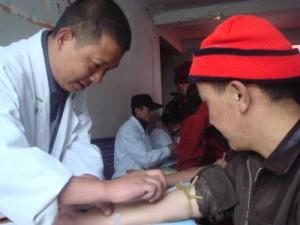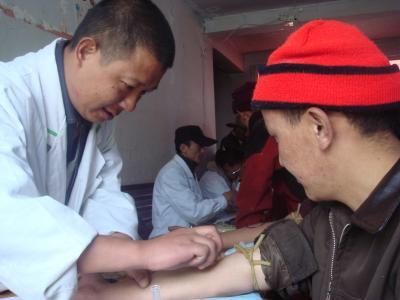
Tibetans were able to adapt to high altitudes thanks to a gene acquired when their ancestors mated with a species of human they helped push to extinction, according to a new report by University of California, Berkeley, scientists.
An unusual variant of a gene involved in regulating the body’s production of hemoglobin – the molecule that carries oxygen in the blood – became widespread in Tibetans after they moved onto the high-altitude plateau several thousand years ago. This variant allowed them to survive despite low oxygen levels at elevations of 15,000 feet or more, whereas most people develop thick blood at high altitudes, leading to cardiovascular problems.
“We have very clear evidence that this version of the gene came from Denisovans,” a mysterious human relative that went extinct 40,000-50,000 years ago, around the same time as the more well-known Neanderthals, under pressure from modern humans, said principal author Rasmus Nielsen, UC Berkeley professor of integrative biology. “This shows very clearly and directly that humans evolved and adapted to new environments by getting their genes from another species.”
This is the first time a gene from another species of human has been shown unequivocally to have helped modern humans adapt to their environment, he said.
Nielsen and his colleagues at BGI-Shenzhen in China will report their findings online July 2 in advance of publication in the journal Nature.
The gene, called EPAS1, is activated when oxygen levels in the blood drop, triggering production of more hemoglobin. The gene has been referred to as the superathlete gene because at low elevations, some variants of it help athletes quickly boost hemoglobin and thus the oxygen-carrying capacity of their blood, upping endurance. At high altitude, however, the common variants of the gene boost hemoglobin and its carrier, red blood cells, too much, increasing the thickness of the blood and leading to hypertension and heart attacks as well as low-birth-weight babies and increased infant mortality. The variant or allele found in Tibetans raises hemoglobin and red blood cell levels only slightly at high elevation, avoiding the side-effects seen in most people who relocate to elevations above 13,000 feet.
“We found part of the EPAS1 gene in Tibetans is almost identical to the gene in Denisovans and very different from all other humans,” Nielsen said. “We can do a statistical analysis to show that this must have come from Denisovans. There is no other way of explaining the data.”
___________________________________
 A Chinese researcher collects a blood sample from an ethnic Tibetan man participating in the DNA study. Credit: Beijing Genomics Institute (BGI-Shenzhen) photo
A Chinese researcher collects a blood sample from an ethnic Tibetan man participating in the DNA study. Credit: Beijing Genomics Institute (BGI-Shenzhen) photo
______________________________________________
The researchers first reported the prevalence of a high-altitude version of EPAS1 in Tibetans in 2010, based on sequencing of the genomes of numerous Han Chinese and Tibetans. Nielsen and his colleagues argued that this was the result of natural selection to adapt to about 40 percent lower oxygen levels on the Tibetan plateau. That is, people without the variant died before reproducing at a much higher rate than those with it. About 87 percent of Tibetans now have the high-altitude version, compared to only 9 percent of Han Chinese, who have the same common ancestor as Tibetans.
Nielsen and his colleagues subsequently sequenced the EPAS1 gene in an additional 40 Tibetans and 40 Han Chinese. The data revealed that the high-altitude variant of EPAS1 is so unusual that it could only have come from Denisovans. Aside from its low frequency in Han Chinese, it occurs in no other known humans, not even Melanesians, whose genomes are nearly 5 percent Denisovan. A high quality sequence of the Denisovan genome was published in 2012.
Nielsen sketched out a possible scenario leading to this result: modern humans coming out of Africa interbred with Denisovan populations in Eurasia as they passed through that area into China, and their descendants still retain a small percentage – perhaps 0.1 percent – Denisovan DNA. The group that invaded China eventually split, with one population moving into Tibet and the other, now known as Han Chinese, dominating the lower elevations.
He and his colleagues are analyzing other genomes to pin down the time of Denisovan interbreeding, which probably happened over a rather short period of time.
“There might be many other species from which we also got DNA, but we don’t know because we don’t have the genomes,” Nielsen said. “The only reason we can say that this bit of DNA is Denisovan is because of this lucky accident of sequencing DNA from a little bone found in a cave in Siberia. We found the Denisovan species at the DNA level, but how many other species are out there that we haven’t sequenced?”
Nielsen’s coauthors include former UC Berkeley postdoctoral fellow Emilia Huerta-Sánchez, now at UC Merced; postdocs Benjamin Peter and Nicolas Vinckenbosch of UC Berkeley’s Department of Integrative Biology; and colleagues in China, Hong Kong, Denmark, Saudi Arabia and Turkey.
_______________________________________
Source: Adapted and edited from a University of California press release: Extinct human cousin gave Tibetans advantage at high elevation
_______________________________________________
Read about the most fascinating discoveries with a premium subscription to Popular Archaeology Magazine. Find out what Popular Archaeology Magazine is all about. AND MORE:
On the go? Purchase the mobile version of a recent issue of Popular Archaeology Magazine here for only $2.99.
Popular Archaeology’s annual Discovery Edition eBook is a selection of the best stories published in Popular Archaeology Magazine in past issues, with an emphasis on some of the most significant, groundbreaking, or fascinating discoveries in the fields of archaeology and paleoanthropology and related fields. At least some of the articles have been updated or revised specifically for the Discovery edition. We can confidently say that there is no other single issue of an archaeology-related magazine, paper print or online, that contains as much major feature article content as this one. The latest issue, volume 2, has just been released. Go to the Discovery edition page for more information.



